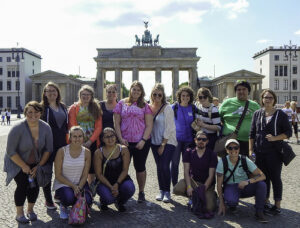Last Updated on July 13, 2016 by cassnetwork

KOKOMO, Ind. — Standing on cliff tops nearly 200 feet high, looking straight down to Omaha Beach and the English Channel gives a perspective on the bravery of American soldiers invading on D-Day.
Nearly seventy-two years after Allied troops began the assault that freed Europe from Nazi rule, 14 Indiana University Kokomo students personally experienced the importance of that pivotal World War II event.
“You can read about it, and watch movies about it, but to experience it is another thing entirely,” said senior Dustin Dimmitt, Lafayette. “Being there allows you to walk in people’s shoes, and find out what it may have been like to be there on that day.”
The students spent 14 days in four countries this spring visiting places significant to World War II in Berlin, Amsterdam, Bayeux, Normandy, and London. Stops included Haus der Wannsee-Konferenz, where Adolph Hitler devised the “final solution” of the genocide of approximately six million Jews and others deemed undesirable; The Anne Frank House, where the teen who became famous after her death for her diary lived in hiding with family and others for two years; Sachsenhausen concentration camp, the Dutch Resistance Museum, and British Prime Minister Winston Churchill’s war room
Seeing these sites in person drove home the lessons taught in their class, “On the Front Lines: World War II in Literature and Film,” taught by Kristen Snoddy, senior lecturer in English, assisted by Sarah Heath, associate professor of history. The class focused not only on the military side, but also on contributions by and impact on everyday people.
Allyson Boyd found the contrast between the beauty of the beach, and the brutality of the battle that took place on it striking. More than 400,000 Allied and German troops were killed, wounded, or went missing during the Battle of Normandy.
She said some thought it strange that parts of the area are recreational sites, where people enjoy picnics and other beach activities.
“One of the students in our group brought up that this is what the soldiers were fighting for, when they fought the Nazis,” she said. “They were fighting for the freedom to use these beaches. It’s a memorial spot, but this is what they were fighting for in the first place.”
Heath said books and pictures can tell a story, but in some cases, there is just no substitute for being there in person.
“There’s an iconic photograph of soldiers come out of the transports, and you can see the cliffs of Normandy,” she said. “They had to climb those cliffs, and they look tiny in the picture. When you look down from the top, it completely changes your perspective on how brave they had to be, and what they had to do to secure a foothold in Europe, to turn the tide of the war.”
A French tour guide led them at Omaha Beach, and encouraged them to take stones or sand from it as souvenirs. Snoddy said students were surprised their tour guide, who was close to their own age, was so passionate about the subject.
“They’re two generations removed from the people who participated in the war,” she noted. “Many talked about grandparents who were veterans. I think for many of it, it really emphasized the passion and gratitude that people from other countries have for the American contribution to the war. It provided them a personal connection to that.”
Boyd, from Galveston, described the tour of Sachsenhausen concentration camp as “the most incredibly moving and heartbreaking experience we had.” More than 200,000 inmates, including Jews, political prisoners, resistance fighters, and prisoners of war, passed through the camp, and approximately 30,000 died or were executed.
“I think we all expected it to be intense, but I don’t think any of us anticipated the weight that hits you when you walk through the gates,” she said. “I don’t think you can get the same understanding from a book that we got from the hour we were in the camp.
“We need to know about these devastating things that have happened in the past, so we are educated enough to see it coming in the future, and can do something against it,” she said.
“Walking through it, we felt like it was hard to breathe,” said recent graduate Josselin Schaffer, Kokomo. “We tried to put ourselves in the shoes of those who were imprisoned there. It was very eerie and quiet, with a graveyard feeling about it.”
The tour led to interesting discussions, and debate about how the German people could go along with what was happening, and if they would have the courage to speak up if something similar happened today, Heath said.
“I asked them at what point would you have stood up to say, ‘This isn’t right,’” she said. “Would it have been when Jews were forced to wear a Star of David? Would it have been when they weren’t allowed to go to school? In general, Hoosiers are very polite, and we don’t like to make people upset. When would you stand up, and when would you oppose what seemed to be majority opinion?”
Schaffer was impressed to learn how the American people united behind the cause of World War II.
“It was the first time I really understood the significance of the effort, and the energy of the people to get behind the war,” she said. “Everyone played a part, and that’s what unified the country. I don’t know if we have that feeling today.”
As a literature teacher, Snoddy looked forward to visiting the Anne Frank house, in Amsterdam, and found that no matter how many times she had read the diary, it did not prepare her for what it was like.
“Just physically being in the space made you appreciate even in greater length what it meant for eight people to be in that space for two years, and having to maintain quiet,” she said. “To be able to see what was happening outside of that wall, and to have so many people in close proximity for so long, it’s hard to appreciate that from reading.”
Many students plan to return to Europe, or to seek out other overseas opportunities. Boyd, who graduates in May 2017, said the trip encouraged her to consider looking for a job in Germany.
“It really opens your eyes to what else is out there,” she said. “Before, I planned to stay in this area, because it’s what I know. Now I’m looking into living and working in Europe somewhere. I had never considered that before.”
She was grateful for IU Kokomo scholarships that made it possible for her to go on the trip. All students in the class received Emita B. Hill Scholarships, and others received David Starr Jordan or Selzer International Study scholarships. The trip also received funding from the Kathleen Ligocki International Travel Fund.
“I’m paying my own way through college, with as many scholarships as possible,” Boyd said. “I think that’s one of the things I appreciate so much about IU Kokomo and our community and our alumni. They are so focused on opening doors to opportunity for students.”
Indiana University Kokomo serves north central Indiana.
SOURCE: News release from Indiana University Kokomo






